Vintage OMEGA Speedmaster wristwatches are an amazing addition to any outfit The sleek contours and bold color choices bring back to mind your golden years, alive with colorful muscle cars, jukebox rock, and drive-in theaters.
While modern timepieces may have a number of new bells and whistles, classic vintage watches continue to offer a more stylish and simplistic look. There is a timeless elegance to be found in their classic design.
Thankfully, among the general public, there are people who appreciate the vintage aesthetic, and among those people, there are a select few who make watches. In this day and age, these few have brought the world a beautiful compromise: vintage wristwatches on the exterior and modern ones on the interior. This allows you to enjoy the technology of today, without sacrificing the vintage style.
Imagine your ideal watch. On the surface, it is undeniably classic, with a striking high-contrast color palette, coordinated subdials, and stylized hands. Underneath the surface, it boasts modern upgrades such as a co-axial escapement and up to 60-hour power reserve. It is a practical investment and a statement of your aesthetics and values. The OMEGA Speedmaster 57 is exactly such a watch.
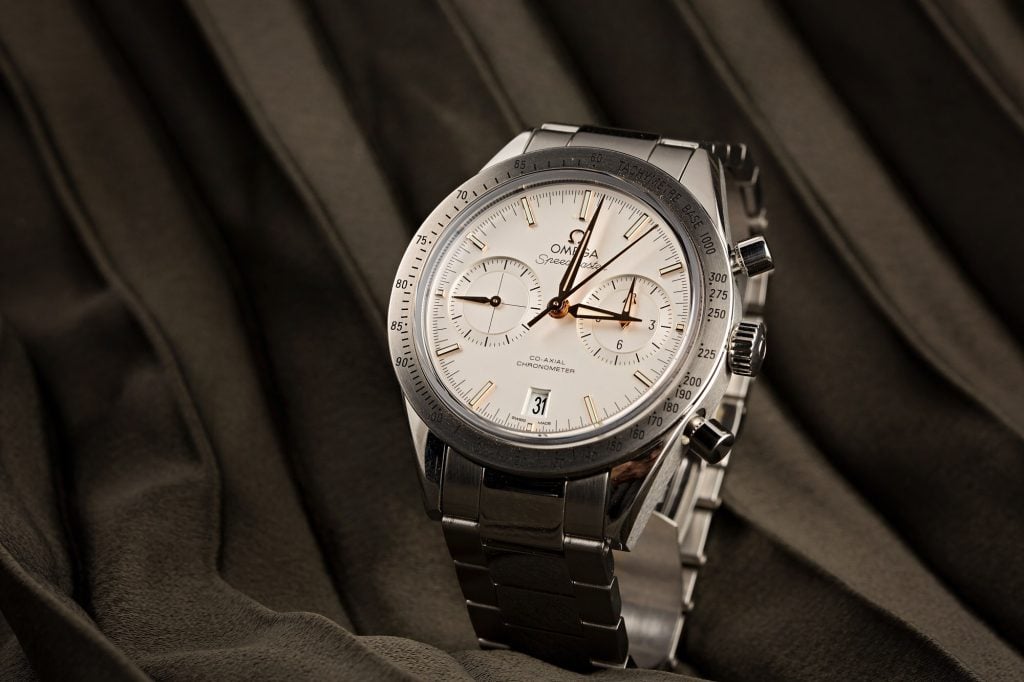
OMEGA Speedmaster History
The original 1957 OMEGA Speedmaster has a unique claim to fame. Not only has it always made a statement in a person’s outfit, but it also had an impact on our quest to the moon! Issued by the National Aeronautics and Space Administration (NASA), worn by astronaut Neil Armstrong, and eventually donated to the National Air and Space Museum in Washington, D.C., the OMEGA Speedmaster chronograph watch was the first watch on the Moon.
The Apollo missions required a manual-winding, waterproof, shockproof, and anti-magnetic wristwatch that could withstand all temperatures between 0 and 200 degrees Fahrenheit and acceleration up to 12 g’s or 12 times the gravity experienced on Earth, and this was the watch for the job. The 1957 OMEGA watch met all the qualifications necessary for Armstrong to bring it to the moon. This made this watch a crucial part of scientific history.
The first OMEGA Speedmaster, the “Broad Arrow” as it was called, was designed in 1957 for performance in high-speed situations. Named after the distinctive shape of its hands, it had a stainless steel case and bracelet, a 39 mm diameter shatterproof Hesalite face, and a glow-in-the-dark radium-accented dial. It was immediately unique, being the first watch to display a tachymeter on the bezel rather than on the dial, which facilitated the rapid calculation of speed over a set distance.
Inside the 1957 Speedmaster was a column-wheel movement called the Caliber 321. This timekeeping mechanism requires extremely precise craftsmanship and is, therefore, popular with vintage collectors and mechanical wristwatch enthusiasts alike. The Speedmaster inherited this particular internal structure from OMEGA’s Seamaster line.
OMEGA created the Speedmaster, Railmaster, and Seamaster watch collection as a trilogy of heirloom quality professional chronograph watches specializing in nautical, racing, and rail contexts, respectively. While all three have proved their value over the decades since their initial release, the Speedmaster line stood out as professional watches for racing, aviation, and space flight.
Continue reading about the history of the OMEGA Speedmaster.
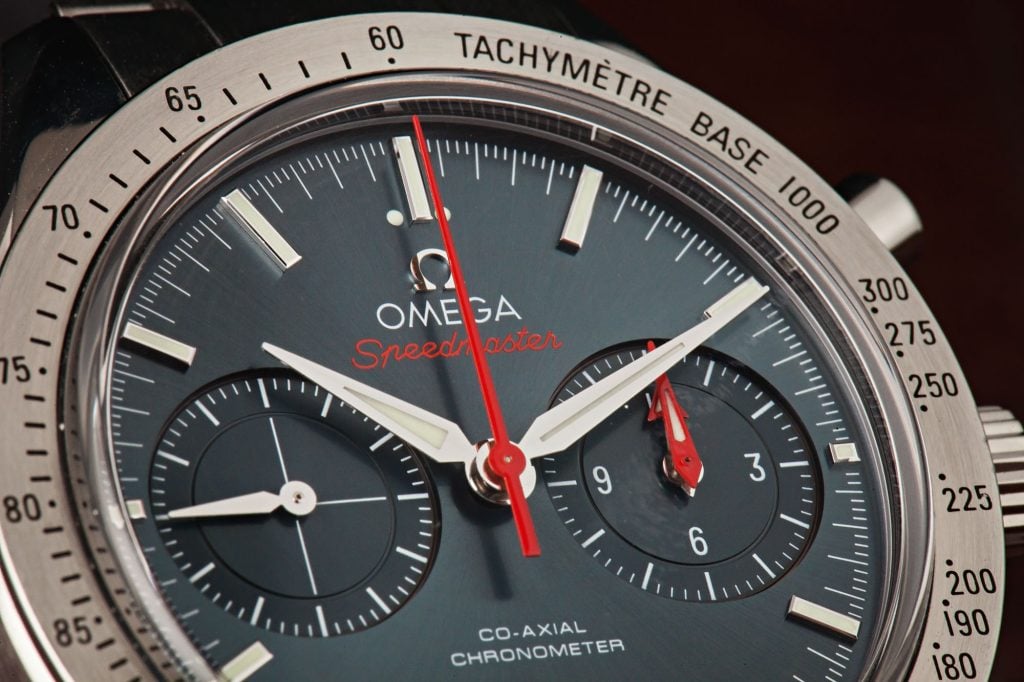
OMEGA Speedmaster ’57 Design
The design of the OMEGA Speedmaster 57 is clearly inspired by the design of the original 1957 Speedmaster. The style of OMEGA Speedmaster 57 is, of course, meant to emulate the style of the ’50s, and it does this in many ways.
To begin with, there is the stainless steel case and bracelet, with the iconic tachymeter clear to see on the bezel. The crystal is polished sapphire, which is identical in appearance but more scratch resistant and durable than Hesalite for regular activities.
The chronograph function includes a 12-hour subdial at three o’clock, a date counter at six o’clock, and a small seconds subdial at nine o’clock. There are two pushers, one on either side of the crown, for toggling the function. These are also vital for maintaining the classic Speedmaster silhouette.
The dial is slightly larger than the original at 41.5 mm, but it maintains the original dark color scheme with high-contrast minimal hour markers and tapered hands. Modern standards have done away with the toxic radium paint, replacing it with phospholuminescent pigments for a safer luminescent effect.
At the top of the dial are the iconic dots on either side of the 12 o’clock marker, underneath which are the brand logo and name, “OMEGA Speedmaster.” This modern remake of the Speedmaster was created in a range of complementary designs, so no matter your particular style, you can still have a vintage accessary in your look!
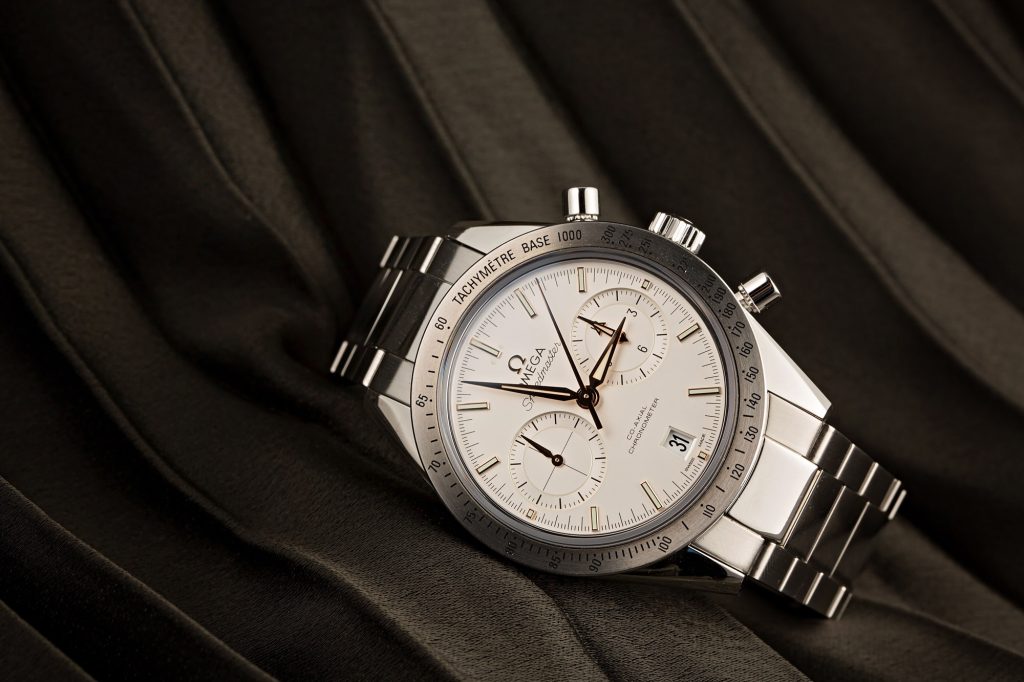
OMEGA Speedmaster ’57 Movement
As we mentioned earlier, the original 1957 Speedmaster contained a distinctive column-wheel movement called the Caliber 321, which was a marvel of craftsmanship. The modern Speedmaster 57 replaces this venerated mechanical movement with an automatic movement called the Caliber 9300.
Like its predecessor, the Caliber 9300 is a product of OMEGA’s in-house Swiss watchmaking expertise. Unlike the Caliber 321, the OMEGA 9300 movement features a co-axial escapement. This type of modern escapement is an innovation on the traditional lever escapement.
The structural differences greatly reduce sliding friction between the internal components, thereby upgrading the watch to be more precise as well as more durable. Additionally, a silicon balance spring improves the movement’s accuracy over time while maintaining its imperviousness to magnetic forces.
Thanks to its double barrel structure, the Caliber 9300 has an impressive power reserve capacity of 60 working hours. Paired with a rotor that is able to wind in both directions, this allows the self-winding mechanism to capitalize on short bursts of movement and further reduces the maintenance requirements of this watch.
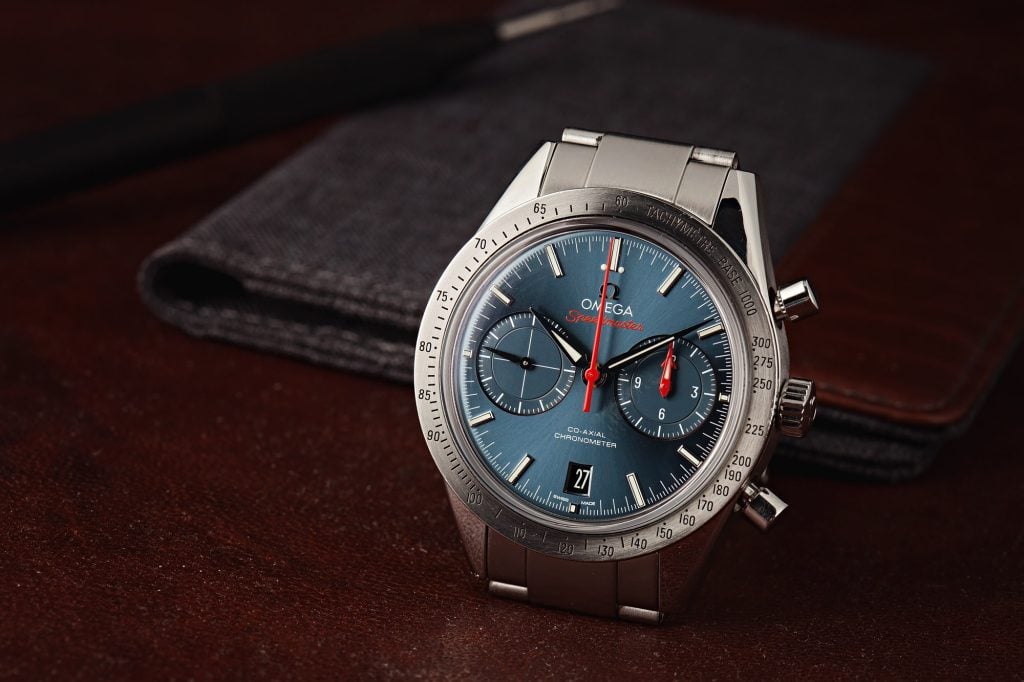
Self-Winding vs. Manual Winding vs. Quartz
A notable difference between the modern Speedmaster wearer experience and the original is that the modern version of the watch is self-winding instead of manual winding. Self-winding watches, which operate with automatic movement mechanisms, are an innovation on manual watches, which rely solely on mechanical movements. They contain a weighted rotor that moves with the wearer’s movements and, in doing so, winds up the mainspring.
A couple of centuries ago, the first wristwatches to be invented were manual winding, and so the purists among vintage wristwatch enthusiasts are most likely to favor this sort of mechanical movement. Manually-wound movements are lighter than automatic movements due to the lack of a weighted rotor.
That said, self-winding watches have become more generally favored for their lower maintenance requirements and hefty, high-quality sensation when worn. The occasional need to manually wind the watch can contribute to the experience of watch ownership without being a chore, and there is no battery to consistently replace or recharge.
These days, there is a third popular type of movement called the quartz movement. Quartz watches are battery-powered and keep time by passing a current through a minute quartz crystal, which causes it to vibrate at a very specific frequency.
They are extremely accurate and low maintenance, but many vintage aficionados consider them modern to a fault, including a battery and electricity running counter to the overall charm of a classic wristwatch. After all, if extreme accuracy and lightness were the goals, the ultimate buyer’s choice would be the latest smartwatch.
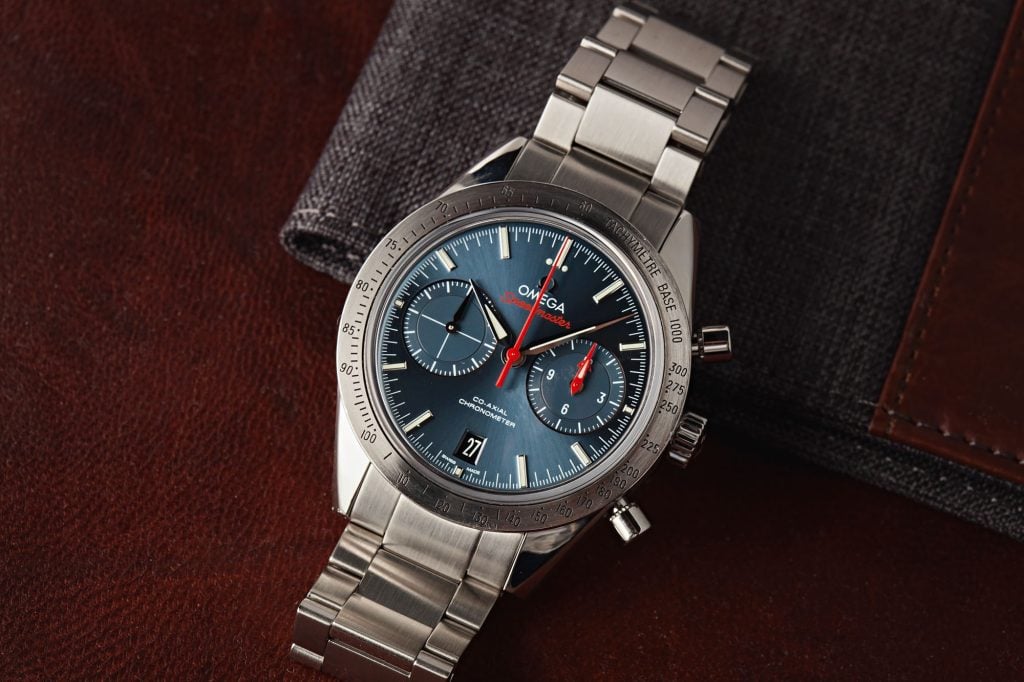
Is the OMEGA Speedmaster ’57 the Right Watch for You?
If you are looking for a watch that pairs timeless historical style with up-to-date timekeeping technology, the OMEGA Speedmaster 1957 is a great place to start looking. The iconic shape, with the bezel-set tachymeter and distinguished dial, speaks for itself.
The automatic Caliber 9300 movement meets modern expectations for accuracy without sacrificing the vintage charm. This watch has made history, but is it the right watch for you? You might wonder if this style watch matches your style and if this specific vintage style watch should be added to your wardrobe. It is important to consider not only your personal style, but also your budget.
If you are a collector or enthusiast of vintage watches, if you would treasure a classic chronograph face with a modern movement heart, and if $11,000 may or may not be a deal-breaker for you, then a pre-owned OMEGA Speedmaster ’57 might just be the perfect watch for you. The average pre-owned price of this model is incredible value for this first-class, high-performance chronograph wristwatch. If you’re looking to purchase a Speedy for your collection, be sure to read our full OMEGA Speedmaster buying guide.

Comments are closed.